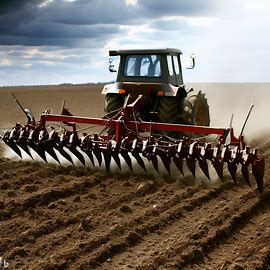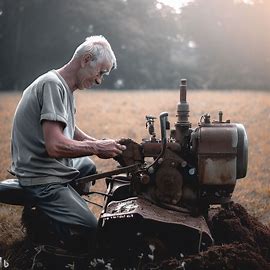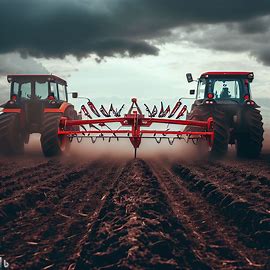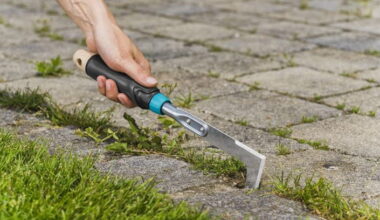There’s a murmur in the fields, an age-old debate that farmers and gardeners alike have tangled with over time. Power harrow vs tiller… Which heavyweight champion rumbles to the top when the soil calls for preparation?
The power harrow lays claim to glory, boasting its ability to churn up earth without flipping layers – a boon for maintaining healthy soil ecosystems. Its engineering prowess allows it to evenly distribute organic matter and nutrients throughout your land; think of it like nature’s very own sous-chef artfully blending ingredients.
On the other hand, brandishing sharp tines and powerful engines, tillers make no bones about their capacity to thoroughly mix and aerate even compacted clay soils. They’re like tough-love personal trainers – breaking things down so they can be built back stronger.
So you see folks, we stand on a precipice of decision between these two titans of turf management. The battle lines are drawn… let’s plow right into it!
Differences in Mechanism and Operational Technique
When it comes to soil preparation tools, both power harrows and tillers offer distinct benefits. Understanding their key features is essential in determining which one is right for your garden.
Power harrows are agricultural machinery designed to break up the soil, preparing it for planting. They consist of multiple rotating blades that dig into the ground, loosening compacted soil and creating a fine seedbed.
In contrast, tillers are smaller gardening equipment used primarily by homeowners or small-scale gardeners. They typically feature rotating tines that churn the soil in a vertical motion.
Key Features of Power Harrows

One of the main advantages of using a power harrow is its ability to cover large areas quickly and efficiently.
With its motorized operation, it can effortlessly penetrate hard ground and alleviate compaction issues.
Another standout feature of power harrows is their ability to achieve an even depth across the entire width of cultivation.
This ensures consistent results when preparing larger fields or gardens for seeding or transplanting.
Additionally, many modern power harrows come equipped with adjustable settings, allowing users to customize aspects such as working depth and speed according to their specific needs.
Key Features of Tillers
Tillers excel at handling smaller gardening tasks due to their maneuverability and ease of use. Their compact size makes them ideal for narrow rows or tight spaces where larger machinery would struggle to access.
Tillers also offer versatility in terms of tine options. Depending on your specific requirements, you can choose between standard cultivator tines or specialized attachments such as furrow openers or weed removers.
Furthermore, tiller models often boast adjustable height settings that enable users to control how deeply they want the tines to penetrate the soil. This flexibility allows for precise seedbed preparation and the ability to avoid disturbing underlying structures, such as tree roots.
Comparing Efficiency and Performance
When it comes to efficiency and performance, power harrows typically have the upper hand. Their robust build and powerful motors allow them to effortlessly penetrate hard ground, saving both time and effort.
Power harrows also excel at achieving a finer seedbed than tillers. The multiple rotating blades create a crumbly texture ideal for promoting seed germination and root development.
On the other hand, tillers are better suited for lighter tasks or small-scale gardening projects. While they might take longer to cover larger areas compared to power harrows, their maneuverability makes them incredibly efficient in tight spaces or around existing plantings.
Durability and Maintenance Requirements
In terms of durability, power harrows tend to be sturdier due to their heavy-duty construction designed for agricultural use. They can withstand rigorous tilling conditions over extended periods without significantly compromising performance.
Tillers, being smaller in size, generally have lighter frames that may not withstand heavy-duty usage as well as power harrows.
However, if maintained properly with regular cleaning and oiling of moving parts, they can provide years of reliable service for home gardeners.
Evaluating Soil Suitability for Power Harrow vs Tiller Use
Soil suitability is an essential factor when deciding between a power harrow or tiller. Power harrows work best on compacted soils that require aggressive cultivation techniques to break up hardened layers effectively.
Tillers are ideal for looser soils that do not require deep penetration but benefit from surface loosening or mixing prior to planting. Their versatility allows them to tackle various soil types without causing excessive disturbance.
Cost Implications: Initial Purchase Price, Operating Costs, Ongoing Maintenance

When considering the cost implications of purchasing power harrows or tillers, it’s essential to evaluate both the initial purchase price and ongoing operating costs.
Power harrows are typically more expensive than tillers due to their larger size and more powerful motors.
However, they often offer superior performance and efficiency for large-scale cultivation needs, justifying the higher upfront investment for serious gardeners or farmers.
Tillers, on the other hand, tend to be less expensive both in terms of initial purchase price and ongoing maintenance costs. They are a cost-effective option for smaller gardens or occasional use.
Environmental Impact: Erosion Control,
Fuel Consumption, Noise Pollution
Considering the environmental impact is crucial when choosing between a power harrow and a tiller. Power harrows can play an important role in erosion control as they break up compacted soil, allowing water absorption rather than runoff. This helps prevent soil erosion during heavy rainfall.
In terms of fuel consumption, power harrows generally require more energy due to their larger size and motorized operation. Tillers consume less fuel overall since their smaller engines have lower power requirements.
Noise pollution is another aspect to consider. Power harrows tend to emit louder noise levels compared to tillers due to their larger engines and heavier construction materials.
Safety Measures for Using Power Harrows versus Tillers

Safety should always be a priority when using any gardening equipment or machinery.
When operating power harrows or tillers, there are several key safety measures that should be followed:
1. Always wear protective gear such as goggles, gloves, ear protection, and sturdy footwear.
2. Familiarize yourself with the specific instructions provided by the manufacturer for each machine.
3. Ensure that proper guards are in place on all moving parts.
4. Keep bystanders at a safe distance while operating either machine.
5 Follow guidelines regarding weight limitations if using attachments with tillers.
6. Regularly inspect and maintain all equipment to ensure safe functioning.
Specific Situations Where One Might Be Preferred Over the Other
While both power harrows and tillers have their unique advantages, certain situations may warrant a preference for one over the other:
1. Large Fields: For larger agricultural fields or gardens, power harrows are more efficient due to their ability to cover significant areas quickly.
2. Compact Gardens: In compact gardens with tight spaces or narrow rows, tillers offer better maneuverability and accessibility.
3. Soil Conditions: If working with highly compacted soils that require deep penetration, power harrows are the superior choice. Lighter soils that only need surface loosening can be effectively handled by tillers.
4. Budget Constraints: If budget is a concern and you have smaller-scale gardening needs, a tiller would be a more cost-effective option compared to investing in a power harrow.
Closing Thoughts
Choosing between a power harrow and a tiller depends on various factors such as garden size, soil conditions, budget constraints, and performance requirements.
By understanding their key features and assessing your specific needs accurately, you can make an informed decision that ensures optimal results for your garden or farm.


